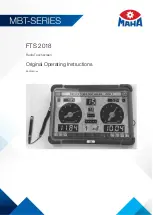
User Manual
Page 15
Version 05
13.3
tergumed
®
710 Rotation, item 10350300
Correct Usage
With this machine, the oblique and deep abdominal muscles are
trained. The training takes place in a closed system, i.e. the feet are in
contact with a footrest, while the knee is fixed from the front. This
allows an optimal stabilisation of the pelvis during the exercise. The
following injuries can be treated and others on this machine after
consulting with the doctor and therapists:
Any injuries of the spinal column such as spinal disc prolapse or
intervertebral disc protrusion, fracture of vertebrae, degenerative
spinal disorders such as scoliosis or ankylosing spondylitis (Morbus
Bechterew). Of course, the machine can also be used for a general
strengthening of the torso and for the prevention of spinal
complaints.
Specific positioning of the person training
The seat height is adjusted via the pressure switch next to the seat, this is either
pneumatic or via the optional electric seat height adjustment. If there is only the
pneumatic seat height adjustment, it is easiest to set the seat to the highest position
before sitting down. The seat height should be set so that the upper body padding lies
on the shoulders after pulling down as well as the thoracolumbar spinal column
transition remains freely movable and is unaffected by the back padding.
The adjustment of the footrests is made mechanically from the sitting position by
pressing the toggle switch attached to the footrest. The graduations for the seat
height and the foot rests are located in an inlet in the bottom of the training machine
and on the side of the footrest (adjusting footrest). This allows the patient or trainee
to comfortable read the position form the sitting position. The ventral knee fixation
padding can be adjusted in height by releasing the corresponding fulcrum pin. The
height should be selected so that the top edge of the padding is aligned at the tibial
tuberosity so that there is no pressure on the patella. The knee padding can then be
released via the pressure switch and pulled to the knee. After that the fixing unit can
be locked again by releasing the pressure switch, to achieve an optimum stabilisation.
Then the lateral pelvic fixation is adjusted by turning the laterally mounted fastening
wheel so that the pelvis is securely clamped between two pelvic paddings. The starting
position can be adjusted in 10° steps to the required start angle. The graduation for
the starting position is in an inlet in the bottom of the training machine. This allows
the patient or trainee to read the position form the sitting position. The starting
position can be adjusted easily using the actuator above the upper torso fixation on
the right. The adjustment attached to the upper torso fixation on the left allows you to
push the fixation on the upper torso, to obtain an optimal force transmission to the
weight stack. The weight load can be set via the pin on the weight block.
Activated muscles
Obliquus externus abdominis muscle
obliquus internus abdominis muscle
rotatores muscle
Summary of Contents for 10350100
Page 1: ...Page 1 User Manual 0123 ...
Page 2: ......
Page 24: ...Page 21 15 Training weight Cervical Trainer ...
Page 25: ...Page 22 ...









































